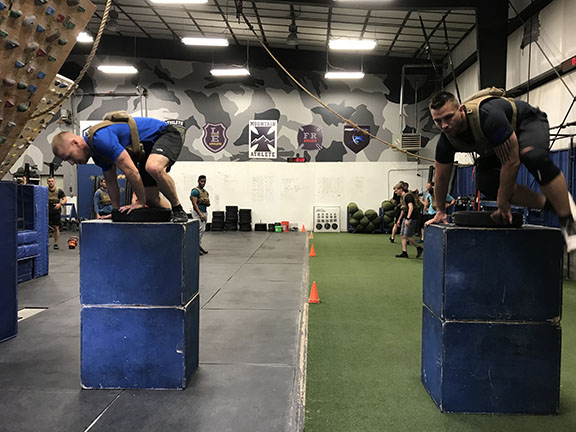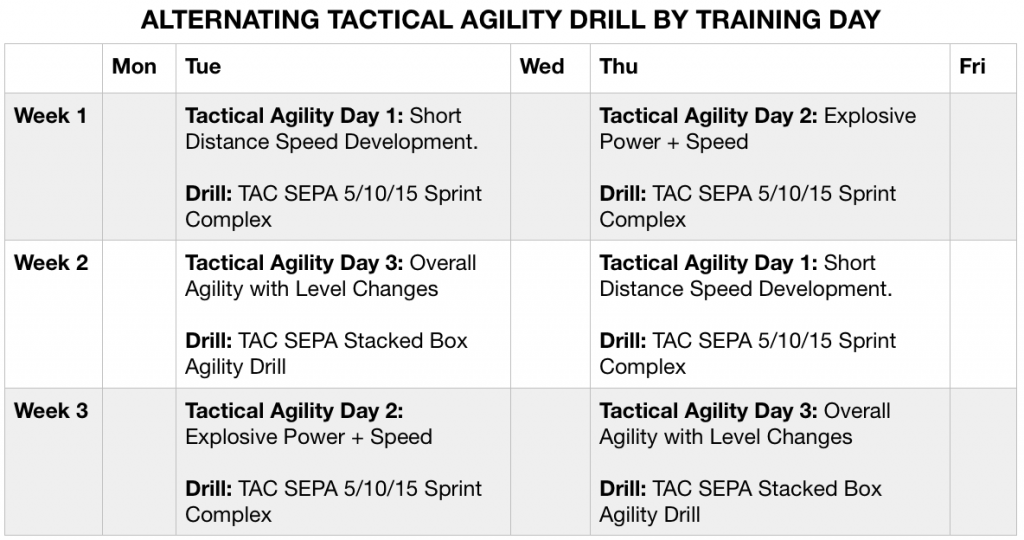
By Rob Shaul
MTI began thinking about, and programming for Tactical Agility on 2019. I’d been exposed to the agility drills being promoted/recommended from the National Strength & Conditioning Association, and realized immediately they were simply re-tread agility drills and methodologies developed for stick and ball athletes.
We could do better.
MTI’s Tactical Agility Evolution
MTI’s Tactical Agility programming is still evolving. Ultimately we hope to develop tactical-specific agility standards, exercise methodologies, and programming.
MTI’s Tactical Agility drills and programming has always been aimed at improving tactical athlete’s speed and coordination for jumping over obstacles, crawling under obstacles, and movement under fire. By incorporating these drills and movement into our Base Fitness programming for Military, Law Enforcement and Fire/Rescue athletes, we ensure that the first time our athletes have to move like this in a dangerous, real-world situation, won’t be the real thing.
We called our first approach, “TAC SEPA” – which was an acronym for Tactical Speed, Explosive Power, and Agility, and many of our tactical agility drills still begin with that acronym. Last year I simplified this to simply “Tactical Agility.”
The drills we’ve developed still apply, but our drill categorization and programming application have evolved.
Drill Categories and Programming
When designing Tactical Agility drills, we aim to train and improve the following agility attributes:
(1) Basic Short Distance speed – both lateral and linear. Drills in this category are aimed at improving the tactical athlete’s ability either to quickly close the distance to a threat or quickly escape a threat. Video below of the 50m Down/Back/Down Shuttle is an example:
(2) Explosive Power and Speed – both lateral and linear. Goal is to prepare train the tactical athlete for quick movement under fire. Video below of the Tactical Pro Agility Drill is an example:
(3) Agility focused on developing faster, more fluid movement with direction and level changes. Both lateral and linear movement. All-encompassing drill aimed at training movement under fire, movement over/under obstacles, etc. Video below of the Stacked Box Agility Drill is an example:
(4) Unloaded and loaded drill execution. Unloaded to introduce athletes to the drills/movements/skills and loaded (body armor, duty belt, bunker gear) to practice the movements in a mission-direct manner for better transfer to the field.
When comparing MTI’s Tactical Agility drills to typical stick-and-ball sport agility drills two differences stand out: (1) Level Change, and (2) Loading.
Most, if not all, of MTI’s Tactical Agility Drills involve some type of level change – from prone on the ground to standing, from standing to prone, from standing up and over and obstacle, and from prone to standing to up and over an obstacle.
The chart below breaks down MTI’s Tactical Agility Drill Categories, and examples of corresponding drills:
|
DRILL CATEGORY |
MTI DRILLS |
|
Short Distance Speed Development |
TAC SEPA – 10 Yard Sprint from Perpendicular Prone |
|
Explosive Power + Speed |
TAC SEPA – Half Box Agility Drill |
|
Overall Agility with Level Changes |
TAC SEPA – Crawl/Sprint/Crawl/Sprint Drill |
Tactical Agility Programming In Base Fitness Cycles
We currently deploy two general programming methodologies for Tactical Agility:
(1) Alternate Tactical Agility Drill Category by day, based on Tactical Agility days in the cycle:
Day 1 – Short Distance Speed Development
Day 2 – Explosive Power + Speed
Day 3 – Overall Agility with Level Changes
See the example below of the first 3 weeks of a 7-week Base Fitness cycle – where we train Tactical Agility as a 1/2 session on Tuesdays and Thursdays:

2) Focus on one Tactical Agility Drill Category for the entire cycle. Every drill in the cycle will fit into the appropriate drill category:
7 Week Cycle 1 – Short Distance Speed Development (all drills)
7 Week Cycle 2 – Explosive Power + Speed (all drills)
7 Week Cycle 3 – Overall Agility with Level Changes (all drills)
Tactical Agility Drill Deployment In the Training Session
Our current approach is to deploy Tactical Agility drills as the first approximately 30-minutes of a 60-minute training session, including the warm up.
The warm up is designed to prepare the athletes for the Tactical Agility drill which follows. After the warm up, we use Parts (1) and (2) of the session for the individual drill. We only complete one Tactical Agility Drill per training session, but complete it first unloaded, then loaded:
- The Tactical Agility Drill is completed first unloaded (Part 1), for 5 rounds, with the first round completed at half-speed.
- The same Tactical Agility Drill is then completed loaded (Part 2), for 5 rounds, with the first round completed at half-speed.
- Athletes are given plenty of rest (45-60 seconds) between rounds. Tactical Agility programming isn’t conditioning – we want the athletes as fresh as possible between individual efforts so they can focus on speed, coordination, and agility.
Finally, we complete the Tactical Agility portion of the training session first.
See the Training Session below for an example of a combined Tactical Agility / Strength training session:
Obj: Tactical Agility, Strength
Warm Up:
3 Rounds
-
- 10x Goblet Squat @ 12kg
- 5x Box Jumps @ 20″
- 5x Hand Release Push Ups
- 4x Prone to Sprint
- Instep Stretch
Training:
(1) 5 Rounds
-
- TAC SEPA – Tactical Pro Agility to Stacked Box Drill
- Rest 45 Seconds
** Complete Round 1 at half-speed, and Rounds 2-5 at full speed
(2) 5 Rounds
-
- TAC SEPA – Tactical Pro Agility to Stacked Box Drill wearing 25# Weight Vest
- Rest 45 Seconds
** Complete Round 1 at half-speed, and Rounds 2-5 at full speed
(3) Work up to 1RM Front Squat
(4) 5 Rounds, Every 90 Seconds ….
-
- 4x Front Squat @ 80% 1RM
(5) Foam Roll Legs, Low Back
Final Thoughts
Tactical agility, though 3 years old now, is still the “youngest” fitness attribute in MTI’s Base Fitness programming for tactical athletes, and the theory is still evolving.
Response from athletes we work within the gym and remotely has been positive. If not made to train Tactical Agility in a MTI training session, few would move like this in training on their own. From MTI’s perspective, with our primary goal to improved Mission-Direct performance, the last thing we want to happen is to have the first time one of our athletes has to move from prone, to a short sprint, to over an obstacle to prone again, in kit, be during the real thing.
We want them to know what this feels like, and have some experience/agility on how to execute this type of movement during their day-to-day, Base Fitness training.
Questions, Comments, Feedback? Email rob@mtntactical.com
You Might Also Like 5 Types of Tactical Athletes & Their Fitness Demands
STAY UPDATED
Sign-up for our BETA newsletter. Training tips, research updates, videos and articles - and we’ll never sell your info.
